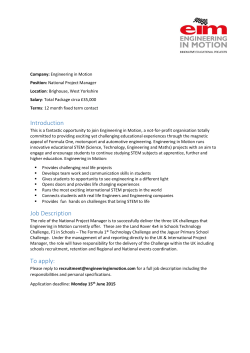
ABSTRACT MISFN 2015
ABSTRACT MISFN 2015 Central Michigan University Development Session A A1 Callan S.P, Gestational exposure to abuse levels of inhaled toluene disrupts acquisition of water T-maze learning but not in a subsequent reversal task. A2 Doyle D. Role of docosahexaenoic acid (DHA) and other polyunsaturated fatty acids on neural stem cell differentiation A3 Hect J.L. Susceptibility weighted imaging (SWI) study of age-related changes in non-heme iron in children and adolescents A4 Knouna K.M. The role of adenylyl cyclases 1 and 8 in survival pathways in ethanoltreated neonatal mice: a FASD model A5 Susick L.L Neonatal ethanol exposure or lack of adenylyl cyclases 1 and 8 increases psd-95 expression in the striatum of mice Session B B1 Gupta S. Developing a cell culture model to study neuropsychiatric diseases B2 Huisingh N. Nato3 induces the expression of key DA neurons in a regionally and temporally specific manner in the developing CNS B3 Mooney-Leber S.M. Repetitive neonatal pain with reduced maternal care: a novel approach to mimicking NICU environmental stressors in rats B4 Toupin N. An experimental design: organizational effects of combined developmental aromatase inhibition and endocrine disruption on brain morphology & reproductive behavior in the Norway rat (Rattus norvegicus) Neural Excitability, Synapses, and Glia: Cellular Mechanisms Session A A6 Michmerhuizen N.L. Effects of insulin in the nucleus accumbens Session B B5 Etnyre E.L. Dexmedetomidine, a norepinephrine A2A receptor agonist, decreases serotonin turnover in the rat brain B6 Wing S. Role of Slp4 in neuroendocrine vesicle docking and fusion B7 Sherer K.R. Functional consequences of amino acid variation in pain-pathway Kv1 channels in a wild rodent (onychomys) exhibiting reduced pain sensitivity Disorders of the Nervous System Session A A7 Altemus M. Changes in polyglutamine repeat length alter disease progression in a mouse model of Kennedy’s disease A8 Iraji A. A comprehensive connectome scale assessment of mTBI using structural and functional connectivity A9 Bielak J.T. Effects of repeated yohimbine and yohimbine-baclofen combinations on ethanol self-administration A10 Bosse K.E. Genetic deletion of adenylyl cyclase 1 impairs ethanol-mediated neuroadaptive effects on locomotor sensitization and striatal NMDA receptor function A11 Combs B. Characterization of tau aggregation induced by arachidonic acid and eicosanoids A12 Fischer D.L. Canonical and non-canonical trkB signaling in the effects of longterm, high frequency subthalamic nucleus deep brain stimulation on Parkinson’s disease. A13 Huffman L.D. The efficacy of bone marrow-derived mesenchymal stem cells in treating glioblastoma multiforme A14 Kaska S. Role of ventral tegmental area TORC2 signaling in stress-induced morphine reward A15 Kaya C.B. Neuronal, glial and neural stem cell markers in wild-type and R6/2 (transgenic mouse model of Huntington's disease) mesenchymal stem cells A16 Killinger B.A. Parkin knockout rats develop Parkinson’s disease-like motor symptoms and pathology following exposure to methamphetamine A17 Lansdell T. The role of parkin on proteasome activity in brain regions containing differentially susceptible central dopaminergic neurons A18 Lombardo J.N. Repeated toluene exposure does not increase activation of dopaminergic cells in the nigrostriatal pathway of adolescent mice A19 Thibault M.A. Region-specific induction of FosB isoforms in mouse brain after stress or chronic fluoxetine exposure A20 Parker S.S. The utilization of Engrailed 1 in the differentiation of mesenchymal stem cells into dopamine-like neurons A21 Polinski N.K. Impact of aging on recombinant adeno-associated and lentiviral vector-mediated transduction of the rat nigrostriatal and striatonigral system A22 Schneider B.L. Enhanced fear conditioning and subregional changes in hippocampal excitatory/inhibitory tone following mild traumatic brain injury in mice A23 Shall G. Optimal generation of dopaminergic neurons from rat bone marrow derived stem cells A24 Taylor T.N. Deciphering the role of neuroinflammation in the early events of Alzheimer's disease A25 Weinberg R.B. Evidence for a neuroprotective microRNA pathway in mild cognitive impairment A26 Welchko R.M. Trans-differentiation of mesenchymal stem cells into dopaminergic neurons for cell transplantation A27 Winner B.M. UCH-L1 is dysregulated in neurotoxicant-treated parkin deficient mice effects of insulin in the nucleus accumbens Session B B8 Bria J.A. Can a drug for Alzheimer’s disease be of benefit in glaucoma? Results from Ach release and cell culture experiments B9 Bullock T.A. Behavioral sensitization following concurrent exposure to MDPV and cocaine in male mice B10 Callan S.P, Repeated exposure to the abused inhalant toluene alters stimulated dopamine release in the accumbens B11 Culver R. Generation and characterization of mouse adenovirus induced pluripotent stem cells utilized for transplantation ameliorates behavioral deficits in the YAC128 mouse model of Huntington’s disease. B12 Deochand M.E. Novel ablation assy reveals eye regenerative program B13 Dunkerson J.A. Does chronically placed embryonic neural stem cell therapy induce restoration of function following cortical contusion impact in adult rats reared in an enriched environment? B14 Gajewski P.A. Epigenetic regulation of the FosB gene in hippocampus B15 Kechner M. Induction of FosB following physical and emotional stress B16 Kelly S.C. Locus coeruleus projection system dysfunction in mild cognitive impairment B17 Learman C. The effect of liraglutide, a glucagon like peptide-1 (GLP-1) analogue, on streptozotocin induced neurodegeneration in cultured mouse neurons: a tool to study sporadic Alzheimer's disease B18 Lisiescki M.J. Binge-pattern cocaine and single prolonged stress cause persistent behavioral hyperarousal, but not increased anxiety-like behavior, in rats. B19 Marlow E.K. Comparing the efficacy of adult mesenchymal stem cells engineered to over-express human or mouse BDNF for the treatment of Huntington's disease in the R6/2 mouse model B20 Matchynski J.J. Disruption of ethanol locomotor-sensitiation by severe, multimodal stress is associated with decreased striatal cb1 B21 Patterson J.R. Potential role of FosB and ΔFosB transcription factors in mediating the differential expression of parkin in central dopaminergic neurons in response to acute neurotoxicant exposure B22 Pezzillo M.D. Analysis of iba-1 and the inflammatory response in young adult mice after mild traumatic brain injury B23 Searles M.A. Does acutely placed embryonic neural stem cell therapy induce restoration of function following cortical contusion impact in adult rats reared in an enriched environment? B24 Shepard A.A. Examining the intracellular breakdown of toxic tau fragments B25 Stewart A.N. Inducing chemotaxis with SDF-1 overexpressing mesenchymal stem cells for repair following spinal cord B26 Tiernan C.T. Tau oligomer formation and phosphatase-activating domain exposure in disease-related forms of tau B27 Wiseman N.M. A preliminary analysis of a pilot study of oxidative cerebral metabolism following mild traumatic brain injury B28 Wu Y. The in vivo effect of oil palm phenolics (OPP) in atherogenic diet induced rat model of Alzheimer's disease (AD) Sensory and Motor Systems Session A A28 Hentig J.T. Zinc sulfate affects ciliated olfactory sensory neurons more than microvillous olfactory sensory neurons in the adult zebrafish A29 Mooney L.N. Examining chemosensory recovery post-atrazine exposure in the crayfish (orconectes virilis) A30 Matyas J.J. Effects of bone marrow-derived MSC transplantation on a rat model of spinal cord injury Session B B29 Groves T. Responses across ocular and presumptive non-ocular cephalic visual inputs in the leech B30 Nwanze C.C. Motor control in clinical populations: activity and motor unit recruitment in seven proximal lower limb muscles B31 Trimpe D.M. Patterns of olfactory bulb cell genesis are altered with long-term, partial deafferentation in adult zebrafish Integrative Systems: Neuroendocrinology, Neuroimmunology, and Homeostatic Challenge Session A A31 Batchelor H.M. Neurotensin regulates the dopamine system and locomotor activity Cognition and Behavior Session A A32 Eagle A.L. ΔFosbB regulation of hippocampal synaptic structural plasticity and learning A33 Figacz A.M. Single prolonged stress in mice impairs extinction retention of conditioned fear and increases serotonergic activity in the amygdala A34 Fitzpatrick C.J. Acute subanesthetic ketamine decreases sign-tracking behavior in rats A35 Marquez G.M. Psychological and physiological effects of gambling B32 Miller D.M To sting or not to sting? B33 Mitchell C.L. Locomotor stimulant effects of 3,4-methylenedioxypyrovalerone (mdpv) and cocaine B34 Wilkinson T.D. The effects of training on the preception of stress when performing a mental rotation task Session B Other Session A A36 Thompson N.A. Teaching neuroscience concepts to elementary school students in a university A37 Johnson J.I. The claustrum of tursiops truncatus: an example of distinctive cetacean brain morphology Session B B35 Gerhold L.M. Bioluminescence-driven optogenetics for neuronal activation and inhibition B36 Miller D.A. Pre-computed optimal current stimuli evoke similar neuron membrane voltage responses as non-optimal stimuli B37 Salois G.J. Housing complexity alters cellular and systemic anatomical characteristics in the rodent dentate gyrus
© Copyright 2025










